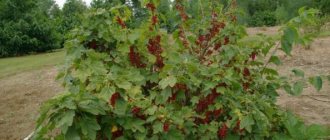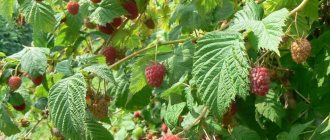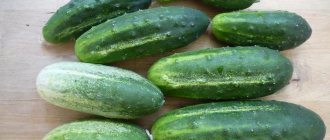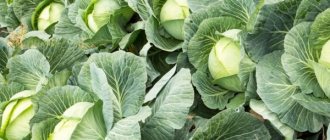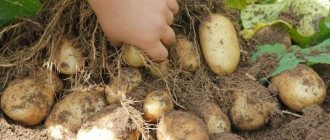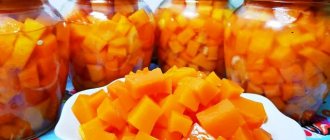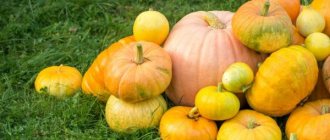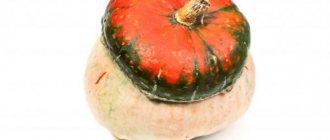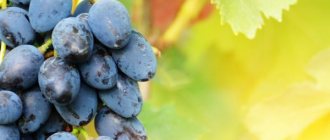Summer residents choose Vitamin pumpkin for its high yield, good resistance to many diseases and excellent taste. Let’s find out what you need to know about one of the most delicious and sweet varieties of pumpkin in order to grow it correctly and get a good harvest.
Vitamin Pumpkin is resistant to many diseases
Pumpkin Vitamin
Vitamin Pumpkin is well stored and transported
Description and characteristics of the variety
The variety was bred at the Krasnodar Research Institute of Vegetable and Potato Farming. In 1992, it was approved for use in the North Caucasus region. This pumpkin was called Vitamin pumpkin not by chance, but due to the increased content of useful elements in the fruit. Its characteristics are presented in the table:
| Parameter | Description |
| Varietal affiliation | Vitamin pumpkin belongs to the group of muscat melons, therefore it differs from other types of fruits both in its noticeable nutmeg aroma and in its elongated shape in the form of a cylinder or pear. |
| Ripening period | The variety is late-ripening - about 124-130 days (at least 5 months) pass from the moment of planting in the ground until the fruits fully ripen. For this reason, the variety is rarely grown in regions with cold climates. |
| Plant characteristics | A plant of medium thickness has vines up to 6 m long. Fruits are formed on them, usually 2-3 pieces. The greyish-green leaves are distinguished by a pentagonal shape resembling a heart. In the area of the veins they are covered with small white hairs. Each leaf is held on a long petiole (up to 25 cm). The yellow flowers are large and borne on long stalks. Due to their bright color and aroma, they attract bees and other insects that take part in the pollination process. |
| External characteristics of the fetus | Vitamin pumpkin weighs on average 4.5-6.8 kg. It has an elongated oval or cylindrical wide shape. The stalk, which can reach half of the fruit, has ribbing. The skin is thin but dense, so the fruit is easy to transport and does not require special storage conditions. It has a dark pink color with a slight orange or brown-brown tint and a segmented surface. It shows a dark green and green coarse mesh, as well as small round and elongated spots that have a lighter shade. |
| Characteristics and taste of pulp | The pulp has a rich bright orange color (close to red) and a thickness of 5 to 10 cm. It is juicy and fibrous, dense and crispy, and most importantly, it has a bright aroma and sweet taste. The seed nest is small and completely filled with loose placentas. The seeds in small quantities have a dirty yellow or brown tint. |
| The benefits of fruits and their use | The pulp of this pumpkin has a high content of nutrients. In particular, it contains 11.5-16.0 mg of carotene. Thanks to this, the vegetable has a number of positive effects on the human body - improves vision, strengthens the digestive organs, accelerates the healing of wounds, and relieves swelling. Pumpkin with such characteristics can be safely included in both baby and dietary foods. Methods of consumption - fresh or processed (the pulp is used to prepare purees, juice, baked goods and other dishes). |
| Productivity | Yield indicators are high – from 1 sq. m plot you can collect about 3.7-4.4 kg of fruit. |
| Disease resistance | The plant is relatively resistant to diseases typical of melons - powdery mildew and late blight. For preventative purposes, it should be fed with balanced mineral complexes during the period of growth, flowering and fruiting. |
The following video briefly describes the characteristics of Vitamin pumpkin:
Useful properties of pumpkin
In addition to the fact that the orange beauty is an incredibly tasty vegetable, it also has numerous beneficial properties. The pulp of nutmeg pumpkin contains in large quantities:
- vitamins A, C, B, B6, E, K and others;
- potassium, magnesium, manganese.
The vegetable is dietary, low-calorie, and is widely used in baby food. In terms of carotene content, pumpkin is “ahead” of carrots, so it should be eaten by those who have vision problems.
Pumpkin fruits are false berries that help remove harmful waste and toxins from the human body, promote kidney health, and slow down the aging process of the body. It is useful to consume this tasty vegetable to improve blood clotting, for people suffering from heart disease, as well as for those who want to improve immunity.
Pumpkin must be on the menu, as it improves metabolism, preserves male strength and helps preserve the beauty of lovely ladies and burn “extra” pounds. Traditional healers consider this vegetable very useful for cancer patients. By the way, not only the pulp, but also pumpkin seeds are used in medicine. They are a very effective remedy in the fight against various parasites of the human body, and pumpkin seed oil is used in the treatment of the prostate gland in men.
And, of course, nutmeg pumpkin has found application in cooking. Its pulp is best consumed fresh, using in salads. Mashed potatoes, various side dishes and cereals turn out delicious; you can also make excellent pancakes from the pumpkin contents. Small nutmeg pumpkin is stuffed, and you can use vegetables or meat as a filling. Pumpkin pies, halva and candied fruits are popular.
Planting methods and timing
Vitamin pumpkin is an extremely heat-loving plant, for which temperature changes are fraught with falling leaves, blackening of the trunk and death. In this regard, it is best to grow pumpkin in seedlings. Direct sowing in open ground is permissible only for residents of the southern regions, where the crop can be harvested in mid-autumn and without fear of frost.
When grown from seeds, the ripening period is delayed, so the warm season will not be enough for the active development of the crop.
In any case, at the time of planting, the soil temperature should be at least +13°C, otherwise the tender roots will die in a cool environment. This will be indicated by withered leaves covered with dark spots.
The timing of planting depends on the method of cultivation:
- Through seedlings . You need to sow the seeds in April in order to transplant the seedlings into open ground in May-June. In this case, the temperature on the thermometer should already remain steadily at least 20°C.
- Direct sowing of seeds into the ground . Sowing work can be carried out at the end of May - at the beginning of June, when the risks of uninvited frosts will be minimized. To determine the optimal time for sowing seeds, you can also rely on folk signs. They say that pumpkin can be planted when viburnum and peonies begin to bloom.
Vitamin pumpkin prefers sandy, sandy loam and light loamy soils for any cultivation method.
Pumpkin Pearl: growing variety
To obtain a good harvest, the creation of suitable favorable conditions will be required. When choosing the right place to plant the Pearl pumpkin, it should be illuminated from all sides, and the soil should be heated to a temperature of 10 to 12 degrees. In this case, the soil is preferably sandy loam or slightly loamy. The place must be protected from winds and drafts.
Preparing pumpkin seeds for planting
Before planting the seeds, they should be properly treated. To do this, prepare a saturated solution of potassium permanganate, soaking the seeds in it for 2 to 3 hours. For additional prevention, thoroughly dried planting seeds are treated with a fungicide.
Preparing a pumpkin bed
The beds are prepared in advance, for which the soil is moistened, loosened, and appropriate nutrients are added. Both organic and mineral fertilizers are poured to the bottom.
On a note!
If cucumbers grew at the site planned for planting, you do not need to apply additional fertilizing.
Planting holes for pumpkin crops are located at a distance of 1 to 1.5 meters from each other
It is important that the bushes do not interfere with each other. Maintain a distance of 1.5 meters between beds
Planting pumpkin seeds Pearl
Pearl pumpkin seeds are planted either at the very end of spring or at the beginning of summer. As a rule, at the beginning of June the earth is already warm enough. The sprouts feel good and begin to develop at temperatures from 18 to 25 degrees.
Planting pumpkins in open ground in spring
A pair of seeds is placed in the hole, placing them 5-6 cm deep into the soil. Sprinkle earth on top. The sprout must grow on its own.
Planting through seedlings
When growing pumpkin in seedlings, the probability of obtaining a rich harvest is greater than when directly sowing seeds in the ground, however, this method is also more labor-intensive, so it is advisable to roughly divide it into several stages.
Seed preparation
The following processing of self-harvested or purchased seeds is carried out sequentially:
- Warming up . The seed should be spread in a thin layer on a pallet and kept for 1-2 months in a warm place, for example, near a stove. Such manipulation will allow the plant to produce a larger number of female flowers, which will have a positive effect on the crop yield.
- Germination test . After warming up, the seeds need to be soaked in a saline solution. Those specimens that emerge must be caught and destroyed, since they are empty and will not produce any shoots. The seeds remaining at the bottom can be used for further processing.
- Hardening . In order for future seedlings to withstand temperature changes, they need to be hardened. For these purposes, selected specimens will need to be wrapped in a damp cloth and kept in the refrigerator for 3 days.
- Disinfection . Carried out to protect the future plant from pest attacks. To do this, the seeds need to be soaked for 10-12 hours in warm water with the addition of a small amount of potassium permanganate or aloe juice.
Sowing seeds for seedlings
At the beginning of May, you can already plant seeds for seedlings. To do this, you will need to prepare separate peat pots, since the crop does not tolerate picking. In order for the root system of the plant to fully develop, the planting containers must be spacious and have a diameter of at least 10 cm.
Planting seeds is done in the following order:
- Fill the pots with nutritious soil.
- Make 2 cm indentations in the pots and place 1-2 seeds in them.
- Lightly sprinkle the holes with soil, and then water it with a spray bottle to lightly moisten it.
- Cover the plantings with plastic wrap to create a mini-greenhouse.
- Place the containers in a sunny place and regularly open the film for ventilation. With the appearance of the first shoots it can be completely removed. In addition, it is necessary to constantly maintain soil moisture, while avoiding excessive moisture.
With the right agricultural technology, the pumpkin will sprout quickly, and it can be transplanted into open ground in early June. By this time the plant should already have 3 leaves.
Transplantation into open ground
The plant does not tolerate acidified soil well, so it is necessary to normalize its acidity after adding organic matter using wood ash. It is enough to scatter it over the beds or prepare a solution for irrigating the soil (2 tablespoons per 1 liter of water). The area should also be fertilized in the fall. An alternative option is to plant green manure.
It is worth replanting the seedlings into a properly prepared bed, following these instructions:
- Dig up the bed, clearing it of debris and plant debris.
- Break the earthen stones.
- Dig small holes 10 cm deep at a distance of 60-100 cm from each other. You should not allow very thick plantings, as this will prevent the wide leaves of the plant from spreading out to their full potential.
- Fill the dug holes with hot water (not lower than 50°C) at the rate of 2 liters per hole if the weather is dry.
- Plant one stem in each hole and cover with soil, completely covering the root collar.
- Mulch the planting with manure or peat. If there is a threat of night frosts, the planting should be temporarily covered with a transparent film.
How to grow
Pumpkin is a heat-loving crop. Caring for it is simple, although it has some peculiarities. Let's consider what should be done to obtain a tasty and beautiful harvest.
Site selection
Land with a deep arable layer and loose soil is ideal for muscat varieties. Many gardeners grow them in compost because it is warm and nutritious. If there is no compost heap, then prepare the beds.
To do this, find a warm and sunny place. First, the bed is dug up in the fall and all the garbage is burned. With the arrival of spring, the earth is dug up again and disinfected. A solution of copper sulfate is suitable for this. The liquid will destroy dangerous microbes and pathogens.
Farmers are also advised to apply organic fertilizers. Before planting, an excellent option would be to fertilize the soil with an ash-based infusion. It will make the soil more nutritious and beneficial for pumpkin, which will have a positive effect on the quality of the harvest.
Seed preparation
When choosing seeds, pay attention to the integrity and appearance of the packaging. We recommend buying them in specialized stores
After purchasing, inspect the seeds and check for germination. Pour them into a container of water and stir in a circular motion. Leave for 10 minutes.
Any seeds that remain on the surface should be discarded because they are empty. Remove those specimens that have sunk to the bottom and dry thoroughly. They are suitable for sowing.
It is better to disinfect even purchased material. An excellent remedy is boric acid. It is enough to soak the seeds in a solution at the rate of 0.2 g per 1 liter of water for two hours. The solution protects pumpkin from fungal infections and increases yield.
Care and feeding
Water the pumpkin moderately, with no more than 2.5 liters of water per bush. The optimal temperature for watering is about 18-22 degrees. It is best to moisten the beds in the early morning or evening to avoid sunburn.
In humid and foggy summers, reduce the amount of water so as not to overwater the plant. Sometimes liquid root fertilizers, such as a solution of nettle or ash, are added to watering.
The beds are loosened every week, it is best to do this before watering. Loosening removes the hard top crust of the earth: it impedes the access of nutrients. Along with loosening, weeds are removed that slow down the development of bushes.
Pumpkin reacts positively to mineral complex fertilizers and organic substances. The most popular among gardeners are:
- "Nutriflex S" - contains magnesium, zinc and calcium, without which normal development of vegetables is impossible.
- “Zircon” - increases yield by 10-15% and improves the plant’s immunity to diseases and insect pests.
- “Mycephyte” - strengthens the root system, making it more developed.
- Chicken manure contains nitrogen, potassium and phosphorus, which strengthen the stems and leaves.
- Ash solution - reduces the acidity of the soil and allows the plant to more easily tolerate climate change. It is especially useful for growing and caring for nutmeg pumpkin in open ground.
Formation of lashes
How to shape butternut squash? The lashes are formed in mid-August to speed up the ripening of vegetables. They always reach for the sun, so they grow in a southerly direction. On long vines, 4-5 pumpkins are formed at once, which do not have time to ripen in time.
Select the largest vegetables and tear off the remaining ovary. Afterwards, pinch each lash. With the help of formation, the growth of the bush stops, and all the nutrition is spent on ripening the pumpkin.
Direct sowing into the ground
In the southern regions, this heat-loving crop can be grown by direct sowing of seeds in open ground. This method requires compliance with the following rules:
- To get a good harvest, you need to prepare the site in advance, taking care of all the fertilizers. For 1 sq. m will need to introduce 6-8 kg of humus. There is an easier way - before planting, place a handful of humus in each hole.
- Arrange the holes in rows according to a 60x60 cm pattern.
- The optimal depth of the holes is about 10 cm. You need to put 2-3 seeds in each of them, and then sprinkle them with earth.
- Mulch the holes with peat on top.
How to grow
Pumpkin variety Guitar is grown in seedlings. However, in regions with a favorable climate, pumpkin can be grown by immediately planting the seeds in the ground.
Planting a plant
Pumpkin seeds begin to be planted in April. Before planting, they must be sorted out and disinfected. It is not necessary to process purchased seeds: information about the preventive measures taken can be read on the packaging.
Self-collected seeds from the previous harvest are treated with a solution of potassium permanganate and water. The seeds are then placed in a damp cloth for several days to allow them to sprout. Sprouted seeds are placed in small pots filled with peat.
After germination, the strongest sprout is selected, the weak ones are removed. Containers with seedlings are left on the south side, as the plant loves warmth and light. To prevent the soil from drying out under the rays of the sun, it is often moistened with water at room temperature.
After 3-4 weeks, the seedlings are planted in holes, abundantly watered. The plant is placed in rows; between the rows leave gaps of 1.3 m, and between the sprouts - at least 90 cm. After planting, the soil is compacted and, if necessary, covered with agrofibre.
Planting with seeds is carried out in the southern regions. Disinfected and germinated seeds are immersed in holes to a depth of 5-10 cm. 2-3 seeds are placed in one hole at once. Plants are watered and covered if necessary. After the sprouts appear, they are thinned out, leaving the strongest ones.
Plant care
This pumpkin variety is easy to care for. However, dense foliage needs thinning. And after 2-3 ovaries form on the stems, the pumpkin is pinched so that the plant is not overloaded and receives full nutrition. Side shoots are also cut off so that the fruits have time to ripen.
16-22 days after planting the seedlings, fertilizing is carried out. The second time fertilizer is applied during the period when the ovaries are formed.
Watering pumpkins is exclusively soil-based. Water should not get on the leaves, as this can lead to the formation of fungal diseases. When grown in greenhouses, pumpkin is watered 2 times a week with warm, settled water. In open ground, the plant needs enough natural precipitation. After watering, the soil must be loosened to ensure an influx of oxygen and kill weeds.
Features of cultivation and possible difficulties
The culture loves warmth and sunlight. Therefore, when planting sprouts in open ground, the weather should be warm, without the risk of recurrence of frost. When transplanted into the ground, the plant must have at least 3 grown leaves.
When looking for containers for pre-seeding, you need to choose spacious and deep containers so that the pumpkin root system does not experience discomfort. When transplanting, take the earthen ball carefully, since the pumpkin root is very delicate. Even with minimal destruction of the coma, the plant may die.
Growing tips from experienced gardeners
Experienced gardeners advise planting pumpkins on light, fertile sandy loam soils with the addition of humus. It is better to use a greenhouse made of polycarbonate, which allows sunlight to pass through. Moderate watering and ventilation are recommended.
In open soils they are planted when the soil temperature reaches +12°C. The soil is fertilized every fall so that when plants are planted in the spring, the soil is filled with the necessary nutrients.
Pumpkin care
It consists of carrying out a set of agrotechnical measures, each of which requires separate consideration.
Watering, loosening and weeding
There is no special scheme for watering the soil, but it must be regular to prevent the formation of a dry crust on the surface of the area. In this case, it is worth focusing on weather conditions: in drought it is worth irrigating the plant 2 times a day at the rate of 5 liters of water per bush, and in rainy weather - water as needed. Pumpkin also needs especially abundant watering (twice a day) during flowering and fruit set.
You need to pour warm water strictly at the root so that droplets do not fall on the leaves and vines. The fact is that they can leave behind dry spots and cause burns to the plant.
At the end of summer, it is necessary to reduce the frequency of watering and completely interrupt it 2 weeks before harvest. Otherwise, the skin of the fruit will be too thin and the flesh will be watery. Such a pumpkin cannot be preserved until winter, since it will quickly deteriorate.
After watering, it is also worth loosening the soil around the plant and weeding to provide air access to the plant’s roots.
Additionally, the ground under the bush should be mulched with humus or straw. This manipulation will retain moisture longer and prevent the growth of weeds.
Feeding
For nutmeg pumpkin varieties, the following fertilizing scheme is used:
- First feeding (before flowering) . With the seedling method, it is carried out 7 days after planting the seedlings in open ground, and with direct sowing - after 3 weeks. For feeding, you should use a solution of mullein or manure, where most of the liquid is removed (1:10). You can also add mineral fertilizers to it - 30-40 g of superphosphate, 15-25 g of potassium sulfate per 10 liters of water.
- Second feeding (during flowering) . The plant should be fed with a solution of 50 g of potassium sulfate and 15-20 g of nitrophoska per 10 liters of water. Until the ovaries appear, it can also be fertilized with wood ash or garden mixture at the rate of 50 g of dry matter per 10 liters of water. In case of cold summer, the plant can be additionally sprayed with a urea solution at the rate of 10 g per 10 liters of water.
If the application of organic fertilizers (mullein infusion or chicken manure diluted in water) increases the acidity of the soil, it will need to be lowered using wood ash. You can simply scatter it over the surface of the bed or add it with watering, having previously prepared a solution at the rate of 2 cups of ash per bucket of water.
Thinning
This manipulation is relevant only for direct sowing of seeds in open ground. It is carried out with the appearance of the first shoots. If 3-4 bushes sprout in one hole, you need to leave one or two of the strongest ones.
Thinning of seedlings is carried out only after the formation of several leaves. Weak specimens cannot be pulled out, as this can cause irreparable damage to all entrances. So, they need to be carefully cut at ground level with garden shears.
Bush formation
To get a good harvest, you must pay due attention to caring for the vines. This involves the following activities:
- During the development process, the pumpkin produces many weaving stems, which, with the help of tendrils, are fixed in the soil and supply the plant with nutrients along its entire length. As soon as it grows, in the places where the tendrils appear, such shoots should be sprinkled with earth and watered. They cannot be moved or cut.
- After the main stem reaches 1.5 m in length, it needs to be pinched.
- When forming bushes, you need to leave 2 lashes on each of them. The rest need to be carefully torn off.
- Leave 2-3 ovaries on one plant, since more fruits still won’t have time to ripen. To do this, the stems must be pinched 50 cm above the fruit.
- Pin the lashes to the ground in several places and sprinkle them with a layer of soil to speed up root formation and promote fruit growth.
For better development in the fall, it is worth placing a board or brick under each vegetable. You can use a more complex option - hang the fruits in a net from a support.
Pest Control
Pumpkin is not the most attractive treat for pests. If they appear, it is mainly at the end of the growing season, when this crop ends its life cycle. Among them you can find:
- pumpkin glass;
- South American leaf beetles;
- edgers or diamondbacks.
The first pest poses a great danger because it eats the stems from the inside. After it attacks the plantings, the plant has little chance of survival. The listed pests must be controlled mechanically. This means that the plantings must be regularly inspected and any pests found must be manually removed.
Diseases and pests
An important point in caring for any plant is protecting it from diseases and pests. Vitamin pumpkin is the most resistant to diseases and pests compared to other varieties. However, it is also susceptible to diseases such as bacteriosis, powdery mildew and white rot.
In case of bacteriosis, the affected plant is completely removed and the place where it grew is disinfected. Then the adjacent stems are treated with Bordeaux mixture (10 g of lime and the same amount of copper sulfate).
Getting rid of powdery mildew is not easy. This fungus is resistant and does not die even in winter. Experienced gardeners fight it with the help of sodium phosphate and colloidal sulfur (for the solution, take 30 g of dry matter per 10 liters of water).
Foliar fertilizers are used against white rot (take 1 g of zinc sulfate, 2 g of copper sulfate and 10 g of urea per 10 liters of water). If the disease has spread greatly, the leaves are removed and the cut areas are sprinkled with crushed coal or wiped with a 0.5% solution of copper sulfate.
Important! To prevent plant disease, follow the rule of crop rotation: grow pumpkin in one place no more than once every 3-4 years.
Harvesting and storage
Harvesting must be done from September to October inclusive, before the onset of the first frost. The following signs will indicate the biological maturity of the fruit:
- the appearance of a clear pattern on the hardened crust;
- drying out of the stalk.
It is better to remove ripe fruits from the garden in dry weather. They need to be carefully cut with a small stalk (5-6 cm), which facilitates their longer storage.
The collected fruits must be sorted correctly. Those that have mechanical damage or have not reached technical ripeness must be processed immediately, while the rest can be stored for winter. Additionally, they should be dried in a warm room or kept in the sun for 2 weeks.
Before the onset of cold weather, the fruits can be stored on the balcony or in a dry room. The main thing is that at night the temperature does not drop below +5...+8ºC. With the arrival of cold weather, the pumpkin needs to be moved to a warm place. A large harvest can be stored in the garden, in a trench, covered with a thick layer of straw and sprinkled with earth. It is important to leave holes for air circulation.
Fruits in storage must be regularly inspected in order to promptly detect signs of spoilage, remove damaged specimens and eat them.
Fodder pumpkin in dacha farming
Feed pumpkin is a valuable, succulent food for farm animals. Its fruits can be processed and are used for making silage with grain waste and feeding fresh.
Beneficial properties of fodder pumpkin
- Increased growth in pigs.
- The amount of milk production increases and the fat content of milk increases.
- Helps increase the reproductive capacity of animals.
- High yield level due to large fruits.
The disadvantages include the lack of a pleasant aroma and low culinary properties.
Hundred Pounds
The Stofuntovka pumpkin variety is a popular mid-season with high yield. The plant has spherical fruits, which are covered with yellow or orange skin with a grayish tint, have excellent shelf life and are well stored throughout the winter, and are not damaged during transportation.
Volzhskaya gray 92
Volzhskaya gray 92 - resistant to diseases and dry weather. The plant bears fruit in the Volga region and produces the richest harvests. The weight of grayish-white flat-round fruits exceeds 25 kg. The pulp is medium juicy, quite dense, and has a rich yellow color with an orange tint.
Advantages and disadvantages
Vitamin Pumpkin is one of the leaders among nutmeg varieties due to the following advantages:
- high yield rates (up to 9 fruits can be obtained from 3 seedlings);
- rapid rooting of seedlings in open ground and active flowering;
- resistance to various diseases and pests;
- good transportability;
- excellent taste for preparing various dishes.
The disadvantages of this variety of melons include:
- excessive thermophilicity (pumpkin is mainly adapted to the weather conditions of the southern regions, therefore it dies at cold temperatures);
- late ripening;
- active growth (the plant occupies a large surface of the bed due to powerful stems, spreading leaves and heavy pumpkins).
The pumpkin grows in all directions and spreads widely throughout the entire bed, so dense planting should not be allowed.
Advantages and disadvantages
The pearl has both advantages and disadvantages.
The advantages of the Pearl pumpkin include:
- drought resistance;
- resistance to low temperatures;
- high taste characteristics;
- Pearl pumpkin has a pleasant aroma;
- the shape of the fruit is very convenient for storage and use;
- high pulp content due to small cavity for seeds;
- excellent ability to be stored for a long time;
- ability to transport over long distances.
There are no significant deficiencies in the variety
. Conventionally, we can distinguish: susceptibility to disease, the presence of peculiarities in relation to the composition of the soil, care, as well as a significant deterioration in taste properties during very long storage.
Reviews about the variety
★★★★★
Margarita, 35 years old, Sochi. I have been cultivating nutmeg pumpkin on my plot for two years now.
The whole family liked this variety for its sweet taste. The thin orange pulp makes excellent dishes. ★★★★★
Svetlana Petrovna, 50 years old, Krasnodar. Pumpkin has been in my garden for a long time.
I especially like the Vitamin variety. I can note its high germination rates and resistance to many diseases that often affect melons and melons. During flowering, the bushes are strewn with bees and butterflies, so the fruits set and grow by leaps and bounds. I recommend it to everyone! ★★★★★
Andrey Stepanovich, 58 years old, Moscow. My neighbor shared her Vitaminnaya pumpkin seeds.
I took a chance and planted through seedlings. I was surprised at what a rich harvest we managed to reap from a couple of bushes. It was not possible to consume all the fruits during the season, so I put them in storage. The keeping quality of this variety is excellent. Hide
Add your review
The experience of growing Vitamin pumpkin is also described in the video below:
Vitamin pumpkin is highly valued by lovers of this vegetable crop because it has excellent taste and is rich in folic acid, carotene, vitamins and minerals. It can be easily grown by residents of warm regions, since it is a heat-loving and late variety of melons. In unfavorable weather conditions, pumpkin can be grown in seedlings in a greenhouse.
0
0
Copy link
Useful properties of butternut squash
Butternut squash contains a huge amount of nutrients, so its nutritional value is very high, unlike other varieties. The keratin content is significantly higher than that in carrots. In addition, pumpkin is rich in minerals, vitamin C and fiber, which improves heart function, etc. Eating this vegetable helps improve vision, slow down skin aging, as it contains antioxidants, strengthens blood vessels, helps cleanse the body of toxins and helps strengthen the immune system. As mentioned above, nutritionists like to recommend adding pumpkin to the diet of people who need not only maintain your figure, but also cope with obesity. This vegetable contains only 45 kcal. per 100 grams.
